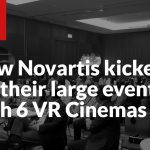Brief history of Virtual Reality until the year 2020
Did you know that the first head mounted display was already developed around 1965? And Oculus first Rift development kit appeared in 2013, almost 40 years later? With the start of a new decade, we thought it was a good time to look back and briefly take a look at the history of Virtual Reality until 2020!
So before we jump into the first signs of the use of Virtual Reality it is good to know that it is hard to exactly point to the origin of virtual reality. Opinions differ a lot when it comes to what can be categorized under virtual reality and what not.
1881: Panorama paintings
But if were to be not so strict you could argue that VR goes all the way back to the 19th century, for example to 1881. This was the year that “Panorama Mesdag” was finished, a cylindrical panorama painting of approximately 14 meters high and with a circumference of 120 meters. The painting, one of the oldest 19th-century panoramas in the world, is a view of the North Sea, the dunes, The Hague and Scheveningen (The Netherlands)
1939: First goggles
With these panorama paintings, there wasn’t anything involved like a VR headset. The first signs of a device that you had to put on your face in order to experience the “Virtual Reality” were there when the View-Master came out, which was patented in 1939. With the View-Master, people could watch seven stereoscopic 3D pairs of small transparent color photographs on film. The design principles of the Stereoscope is used today for the popular Google Cardboard and low budget VR head mounted displays for mobile phones.
1962: First immersive experience
Fast forward to 1962 is when a machine was introduced, known as one of the earliest examples of immersive, multi-sensory technologies. Morton Heilig called the machine the Sensorama. As you can see in the image, there is no headset involved, but a very large machine, packed with a stereoscopic color display, multiple wind fans, odor emitters, a stereo-sound system and a motional chair. This way, the machine was capable of triggering all the senses in an effective manner. The experience is about riding on a motorcycle through New York while feeling the wind blow through your hair, hearing the sounds of the city and inhaling the smells of the city.
1968: First Head-mounted display
A few years later, it is 1968 that most people argue as the year that the first Head-mounted Display (with motion tracking) was developed. This HMD was entitled ‘headsight’ and was made for helicopter pilots in the military. Head movements would move a remote camera, allowing the user to naturally look around in the camera.
1987: Introduction of term “Virtual Reality”
But the Headsight was not actually developed for virtual reality applications (the term didn’t exist then). It was only until 1987 when Jaron Lanier used the term “Virtual Reality” for the first time when developing VR Gear.
1990-2000: Decrease of popularity of VR
During the 1990’s, Jaron Lanier, but also Tom Zimmerman marketed a range of virtual reality gear. However, the hype around the technology had an adverse effect and led to a decrease in its popularity.
2000-2010: Google street view and other technologies
Between the year 2000 and 2010, not much worth mentioning happened when it comes to Head Mounted Displays. However, some technologies related to virtual reality, such as google street view that eventually also supported 3D, were developed in this period.
2010-2015: Virtual Reality reborn
From 2010 onward things started moving quickly again. Palmer Lucky designed the first prototype of the Oculus rift in 2010 and in 2012 they presented the Rift for the first time at the E3 gaming trade show. In 2013 and 2014 Oculus shipped their first and second development kits ordered through their kickstarter project.
2013 was also the year that Valve came into the picture. They discovered and shared the technology of low-persistence displays, making VR content lag and smear free. This was adopted by Oculus and used in all their future headsets.
In 2014, Oculus was purchased by Facebook and also Sony announced a VR headset to be used later with the Playstation 4.
2015-2020: Rise of Virtual Reality
In 2015, HTC and Valve announced the HTC Vive headset, with controllers and base-stations to allow for positional tracking using infrared light. Also, this was the year that Google announced the Cardboard, enabling millions of people to watch VR content for a low price by making use of their own smartphones.
In 2016, HTC was ready to ship its first units of the HTC Vive Steam VR headset. This was the first commercial release of sensor-based tracking, which allowed for free movement by the users within a predefined space in their own living room!
In 2017 Sony filed a patent that indicated they were developing a similar location tracking technology as the Vive for their Playstation VR. It also showed potential for the development of a wireless VR headset. And this was the year that EZ360 developed its first prototype of a kiosk-mode VR player and VR-House was the first to try it out commercially with their clients.
In 2018, Oculus launched the Oculus Go, the first commercially available wireless VR headset with a built-in screen that was affordable. With the launch of this VR headset, organizations started to adopt VR headsets on a larger scale. Using VR Sync, organizations were able to control several Oculus Go VR headsets at the same time from a PC or laptop.
Finally, last year in 2019, the most important developments were that The Oculus Rift S was released on 20 March 2019 and Oculus quest at 21 may 2019. The first consumer-ready wireless VR headset with positional tracking!
2020: What is next?
This was a brief history of Virtual Reality until 2020. We expect a lot of new developments around Virtual Reality this year and the years after. New headsets will arrive, technologies will be developed and the overall quality and comfort of virtual reality will improve. At EZ360 will continue to be the most dedicated VR player and management solution for organizations. We are working on a lot of very interesting features and functionalities that you can make use of later this year and the years after. If you haven’t done so already, make sure to create a free account for EZ360, subscribe to our Youtube channel and stay tuned!





